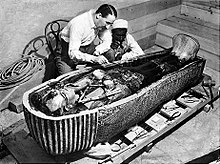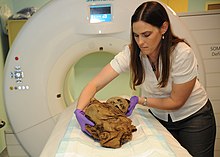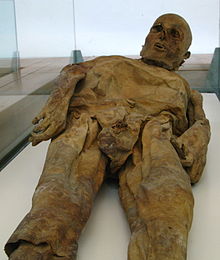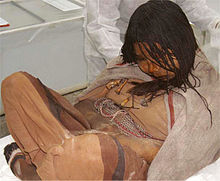Mummy
A mummy is the term used to describe the remains of animal or human bodies that have been protected by physical or chemical conditions from natural processes of decay, commonly subsumed under the term putrefaction, and have been preserved in their general form. A mummy can be artificially produced by man through special procedures (mummification) or can be created quasi "by itself" through naturally occurring processes (mummification); in both cases, the end result is referred to as "mummified".
The term "mummy" is derived from the Persian word mumia (Neo-Persian موم / mūm), which means "bitumen, earth pitch". In Ancient Egypt, the term mumia became eponymous, as the blackish-resinous substances were mostly used for Ancient Egyptian mummies; bitumen was only used in Greco-Roman times.
In order for a mummy to develop, the destruction of the soft tissue of a corpse caused by autolysis, bacteria and insects in particular must be effectively prevented. Arid climates or landscape elements (e.g. caves) and structures through which air continuously flows are conducive to mummification due to the high evaporation rates prevailing there. However, a mummy can also form at temperatures well below the freezing point of water. In the case of bog bodies, also known as mummies, soft tissue preservation takes place in the acidic environment of a raised bog through oxygen exclusion and the action of humic and tannic acids, often dissolving the mineral portions of the bones. In addition, the removal of the viscera and various embalming techniques have proven successful in artificial mummification.
Archaeologically, the definition of mummy is difficult, since originally only Egyptian corpses were called mummies. The term "mummy" has also become established for finds among indigenous peoples of South America (e.g. Paracas culture or from the Nazca culture). The term "mummy" is not bindingly defined for archaeological science. Mostly the term is avoided in Germany, because it is too much associated with Egyptian finds.

Howard Carter at the opened coffin in the tomb of Tutankhamun

Preparation of a Peruvian child mummy for the CT scanner

Human mummy from the 16th century, Venzone, Northern Italy

One of the Llullaillaco mummies from the province of Salta (Argentina)
Mumia
→ Main article: Mumia
Of medical importance was the substance "Mumia" extracted from mummies. Bitumen has been known for a long time among nomadic peoples in North Africa as a wound remedy due to its draining properties (cf. traction ointment). Since it was suspected that Egyptian mummies had been embalmed with it, attempts were made to obtain the expensive substance first by scraping, and later by grinding the mummy itself. Abdul Latif, an Arab traveler of the 12th century, reported that myrrh-scented mummies were sold in Egypt for medicinal purposes. As late as the 16th century and early 17th century, a brisk trade was conducted in Europe, as mummies were considered an excellent remedy for fractures, wounds and contusions. At the beginning of the 20th century, the Darmstadt-based pharmaceutical company Merck sold the products for twelve gold marks per kilogram. Since counterfeits could be discovered, the products were given the names genuine (Mumia vera) and Egyptian (Mumia ägyptica).
Natural mummies
In dry, hot regions, a natural mummification (mummification) results when the soil is salty. There also originated the custom of mummification. Natural mummies are produced
- by storage in caves within absorbent rock, e.g. tuff (such as in the Capuchin Crypt of Palermo),
- by dryness of the soil at the place of burial, e.g. in the Sahara (white mummies), in the Peruvian desert or the Altai mountains,
- as a glacier mummy if the corpse is buried in a very cold place (e.g. glacier or taiga) and "frozen" as it were,
- by a cold drying draught of air, as in the lead cellar of the cathedral at Bremen or on the Great St. Bernard,
- by mineral components of the soil (e.g. alum content),
- by chemical conditions (e.g. tannic acid in bogs)

Detail of a mummy from Guanajuato (Mexico)
Questions and Answers
Q: What is mummification?
A: Mummification is a process of preserving the skin and flesh of a dead body.
Q: How can mummification occur naturally?
A: Mummification can occur naturally due to cold (in a glacier), acid (in a bog), or dryness.
Q: What did the Egyptians use to protect the body of the deceased?
A: The Egyptians used bandages to wrap around the corpse to protect the body from rotting.
Q: Where have mummies been found?
A: Mummies have been found on every continent as a result of natural preservation due to unusual conditions and as cultural artifacts.
Q: How many animal mummies have been found in Egypt?
A: Over one million animal mummies have been found in Egypt, many of which are cats.
Q: What did the Egyptians do to remove the brain from the body?
A: The Egyptians used a hook to remove the brain from the body by taking it out from the nose.
Q: What was buried with the mummy in separate containers called canopic jars?
A: All organs except for the heart were surgically removed and buried with the mummy in separate containers called canopic jars.
Search within the encyclopedia